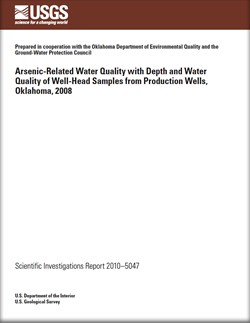Scientific Investigations Report 2010–5047
Abstract
The U.S. Geological Survey well profiler was used to describe arsenic-related water quality with well depth and identify zones yielding water with high arsenic concentrations in two production wells in central and western Oklahoma that yield water from the Permian-aged Garber-Wellington and Rush Springs aquifers, respectively. In addition, well-head samples were collected from 12 production wells yielding water with historically large concentrations of arsenic (greater than 10 micrograms per liter) from the Garber-Wellington aquifer, Rush Springs aquifer, and two minor aquifers: the Arbuckle-Timbered Hills aquifer in southern Oklahoma and a Permian-aged undefined aquifer in north-central Oklahoma. Three depth-dependent samples from a production well in the Rush Springs aquifer had similar water-quality characteristics to the well-head sample and did not show any substantial changes with depth. However, slightly larger arsenic concentrations in the two deepest depth-dependent samples indicate the zones yielding noncompliant arsenic concentrations are below the shallowest sampled depth. Five depth-dependent samples from a production well in the Garber-Wellington aquifer showed increases in arsenic concentrations with depth. Well-bore travel-time information and water-quality data from depth-dependent and well-head samples showed that most arsenic contaminated water (about 63 percent) was entering the borehole from perforations adjacent to or below the shroud that overlaid the pump. Arsenic concentrations ranged from 10.4 to 124 micrograms per liter in 11 of the 12 production wells sampled at the well head, exceeding the maximum contaminant level of 10 micrograms per liter for drinking water. pH values of the 12 well-head samples ranged from 6.9 to 9. Seven production wells in the Garber-Wellington aquifer had the largest arsenic concentrations ranging from 18.5 to 124 micrograms per liter. Large arsenic concentrations (10.4–18.5) and near neutral to slightly alkaline pH values (6.9–7.4) were detected in samples from one well in the Garber-Wellington aquifer, three production wells in the Rush Springs aquifer, and one well in an undefined Permian-aged aquifer. All well-head samples were oxic and arsenate was the only species of arsenic in water from 10 of the 12 production wells sampled. Arsenite was measured above the laboratory reporting level in water from a production well in the Garber-Wellington aquifer and was the only arsenic species measured in water from the Arbuckle-Timbered Hills aquifer. Fluoride and uranium were the only trace elements, other than arsenic, that exceeded the maximum contaminant level for drinking water in well-head samples collected for the study. Uranium concentrations in four production wells in the Garber-Wellington aquifer ranged from 30.2 to 99 micrograms per liter exceeding the maximum contaminant level of 30 micrograms per liter for drinking water. Water from these four wells also had the largest arsenic concentrations measured in the study ranging from 30 to 124 micrograms per liter. |
First posted July 13, 2010 For additional information contact: Part or all of this report is presented in Portable Document Format (PDF); the latest version of Adobe Reader or similar software is required to view it. Download the latest version of Adobe Reader, free of charge. |
Becker, C.J., Smith, S.J., Greer, J.R., and Smith, K.A., 2010, Arsenic-related water quality with depth and water quality of well-head samples from production wells, Oklahoma, 2008: U.S. Geological Scientific Investigations Report 2010–5047, 38 p.
Abstract
Introduction
Study Aquifers
Geochemical Processes Affecting Arsenic Concentrations in Groundwater
Methods of Study
Arsenic-Related Water Quality with Well Depth
Arsenic-Related Water Quality in Well-Head Samples
Summary
References
Appendixes